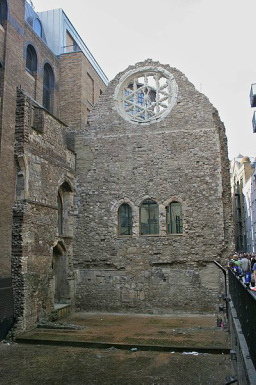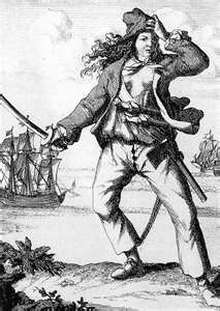 Today, I'm taking part in a "blog hop" celebrating the launch of Castles, Customs and Kings, a compilation of essays from the English Historical Fiction Authors blog. If you go to the blog, you can enter for a chance to win a free copy! "Read the history behind the fiction and discover the true tales surrounding England's castles, customs, and kings." --Official excerpt  I have a piece in here about the political activities of Quaker women, who spent a lot of time speaking against the King. But today, since a number of bloggers are discussing palaces and castles, I thought I would write about my personal experience living near the ruins of Winchester Palace in London. ***********************************************************************************  Photo: Mike Peel. 2009. www.mikepeel.net Photo: Mike Peel. 2009. www.mikepeel.net When I was a pirate serving aboard the Golden Hinde, the museum replica of Sir Francis Drake's ship dry-docked in the Thames--(okay, I was a tour guide or 'living history interpreter')--I spent a lot of time gazing at the ruins of Winchester Palace. Located in Southwark, near Shakespeare's Globe, the Clink and the Anchor (most fun pub in London), the ruins of the 13th century Winchester Palace loom incongruously from a modern parking garage (Car park!)  Liam Wales © Eng. Her. Photo Library Liam Wales © Eng. Her. Photo Library Not to be confused with the more illustrious Winchester Castle--or Winchester Cathedral, as many a dismayed tourist has done—Winchester Palace was founded by Bishop Henry de Blois, brother of King Stephen, in the early 13th century. It was designed to serve as a place for visiting bishops to stay when they journeyed to London. According to the English Heritage website, the Palace once consisted of a Great Hall, which led to a buttery, pantry and kitchen. In its late medieval heyday, the Palace had been a site of great spectacle, feasts and grand dinners, even have hosted the wedding dinner of James I of Scotland and Joan Beauford in 1424. The majestic qualities of the palace are suggested by the presence of a rose window, a common feature of more lavish churches and palaces built in this time. There is also evidence that the palace had a tennis court, bowling alley and pleasure gardens, to keep the bishops entertained while on royal and administrative business. Underneath the hall was a vaulted wine cellar, no doubt full of great vats and bottles to keep the bishops and their guests merry. There was also a passageway to the river wharf along the south bank of the Thames, to bring supplies into the Palace. The palace seems to have been surrounded around two courtyards, a brew-house and butchery. The Clink prison, under the auspices of the Bishop of Winchester, was also nearby. (Yes, this is where we get the phrase being ‘thrown in the clink.’)  The Rose Window http://www.english-heritage.org.uk The Rose Window http://www.english-heritage.org.uk After the Reformation and King Henry VIII’s dissolution of many church properties, the palace changed its purpose. By the 17th century it was divided into tenements and warehouses. In the 19th century, much of the palace was destroyed in a fire in 1814. The ruins remained in disrepair until the 1980s when the area began to be redeveloped. Now only the bare remains and beautiful rose window suggest the former grandeur of the Palace. When I used to lead school children on tours of the ship, we’d often pause by the Palace ruins. There, I couldn’t help but whisper about the mysterious happenings the Golden Hinde crew had all witnessed during our long moonlit stints on ship watch... A shadow moving slowly through the grounds, when the source of the movement could not be detected.... A flock of black birds, arrayed in a perfect circle, as if convened at a great table.... And most odd of all: one night, our whole crew heard the strands of a madrigal being sung from deep within the ruins...By the time one of us mustered up the courage to peer over the guardrail, the unknown singers had vanished. To this day, I sometimes wonder who those anonymous singers were... But that's the intriguing romance and mystery of the ruins of Winchester Palace....
16 Comments
 Anne Bonny, pirate, defying convention Hearing all the talk about piracy recently makes me think of my own days as a pirate. No, I was no Mary Read or Anne Bonny, two eighteenth-century women who disguised themselves as men in order to serve on a pirate ship. (But seriously, how cool were they? For several years they plundered and stole with the best of them...although of course they were publicly tried as pirates--and for defying conventions for women). But in the 90s, I did pull a short stint aboard the Golden Hinde, the museum replica of Sir Francis Drake's ship that circumnavigated the globe, currently dry-docked in the Thames, near London Bridge.  Golden Hinde (with an "e"!) in London During the week, I was a tour guide--ahem, costumed educator--for tourists and school groups, while on the weekends we ran pirate parties and living histories. We dressed in sixteenth-century sailor garb, which is not as glamorous as you might think. (In fact, once when I was taking my 'tea break' outside the nearby ruins of Winchester palace, a tourist offered me half a sandwich. Yup, she thought I was homeless.) Despite being a certified landlubber, I learned about ratlines, scurvy, gun drills and barber surgery (so gross, but so cool), swabbing the deck (much less cool) and a little tiny bit of nautical stuff, like turning the capstan, moving the yardarm, and of course some random pirate ditties. I was even hoisted once along the yardarm by the master rigger, a nauseating experience that gave me nightmares for some time. I got to talk about weevils, "powder monkeys" (the boys who carried gun powder would sway with the listing ship, looking like monkeys) , and the origins of such phrases as "loose canons" (cannons had to be secured on gun deck), "batten down the hatches" (that one's literal still, right?), and "freeze the balls of a brass monkey." (The last not so naughty as you might think). The best part? We all had to take turns on ship watch, sleeping in Francis Drake's own captain's cabin, while St. Paul's Cathedral gleamed across the Thames. Easily one of the most gorgeous views in London. (The crew and I also spent a lot of time playing sardines among the barrels, and 'tippling down the hatch' but that's entirely another story.) For me, it was a bit of a lark, something wonderful to support me while I worked in London's archives. And Bankside--where the Golden Hinde and Shakespeare's Globe are located--came to feature prominently in Monster at the Gate. I always wondered, though, what it would have been like to have been a real pirate--to have run away from home; to have shunned tradition, convention and stereotypes. Although maybe a few days living among rats, weevils, sickness, and 70 other unwashed bodies might have cured me of that romantic impulse. (Not to mention I think I'm a bit adverse to violence and plundering). But what do you think? Could it have been the pirate life for you? |
Susanna CalkinsHistorian. Mystery writer. Researcher. Teacher. Occasional blogger. Categories
All
Archives
May 2023
|
 RSS Feed
RSS Feed